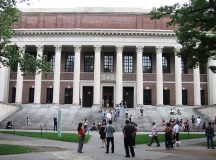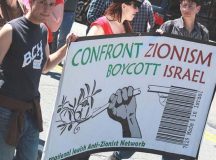Michael Feuer argues that the eruption of protests against Israel after 7 October sounded the alarm of resurgent antisemitism, which was not only horrifying in its own right but also as Deborah Lipstadt warned, symptomatic of pathology that affects everyone, not ‘just’ Jews. He suggests that an unintended positive consequence of the anti-Israel Spring will be a redoubling of our commitment to invest in ‘deferred maintenance,’ not only of our buildings and grounds but of fault lines running deep in our intellectual infrastructure.
Past as Prologue? Words Matter
When Otto Feuer, of blessed memory, was liberated from Buchenwald in April 1945, he made his way to Paris. A border guard generously advised: ‘vous savez, en France on n’aime pas les Juifs’ [you know, in France we don’t like the Jews.] In sharing the memory later my dad quipped, ‘I had survived, and so, apparently, had antisemitism.’ I was reminded of this story when protests erupted, starting on 8 October, 2023. Survivors of the Negev horror were starting to sift through the debris; preparing burials for a ghastly number of murdered relatives of all ages; processing video footage of victims beaten and raped and dragged away at gunpoint; asking themselves what happened to Zionism’s promise to protect Jews from such atrocities. Elsewhere, the familiar game of blame-the-victim started quickly: at Times Square Israel was accused of causing the onslaught and at Harvard 30 student groups held Israel preemptively responsible ‘for all unfolding violence.’
This orgiastic inversion of victim as criminal, of perpetrator as hero, would be repeated ad nauseum. Listen to a freed hostage: ‘The hatred that I thought I had left behind in Gaza was waiting for me online…the movement in the West for a Gaza cease-fire sometimes devolves into full-throated support for Hamas and the hounding of Jews in public spaces.’ It seemed (or so we prayed) that Israel had survived its darkest day since the end of the Shoah. And clearly, so had antisemitism.
Academic year 2023-24 was one for the books. We were hoping for serenity and stability after the pandemic, and then came grief and turbulence. As we begin a new Spring semester, I offer some reflections on what happened and how we might prepare for whatever comes next.
At my institution, whose great namesake had pledged to the Jews of Newport, Rhode Island that America would ‘give to bigotry no sanction,’ electronic graffiti projected on our library wall glorified the ‘Hamas martyrs’ and called for freeing Palestine ‘from the river to the sea.’ After courageously condemning those tropes (the projectors were shut off), our president was accused of gagging free expression. Her critics didn’t know or care about legal provisions that protect some – but not all – speech anywhere and in any form: as explained for example by the former head of the American Civil Liberties Union, ‘nobody has a right necessarily to speak on a particular campus. Campuses can set viewpoint-neutral time/place/manner rules to allocate this scarce resource …’ It was odd to see administrators who spend much of their time protecting everyone’s right to express themselves being told to shut up. Astute observers wondered if policies to protect our safe and comfortable academic environment somehow don’t apply the same way when Jews are under attack.
Numbers Matter Too
We were of course not alone. By mid-Spring 2024 colleges nationwide had become unwilling hosts to ‘encampments’ with students, faculty, neighbors, visitors from other universities, and professional agitators linking arms, waving intifada flags, and wreaking havoc not seen in decades. Now, the word ‘context’ has attained a certain ignominious ring thanks to apologists trying to rationalise the Hamas atrocities. Here, though, I’ll use the word in a different … context. Compared to the real trauma – hostages (alive and dead), families grieving fallen sons and daughters, 70,000 residents of northern Israel exiled in their own land, 45,000 businesses closed, barrages of ballistic missiles launched from Iran and its proxies in Lebanon and Yemen, new uncertainties about who will succeed the devils of Damascus – along with the unspeakable horrors of war suffered by Gazans – our experience is perhaps obviously on a different scale. But we need to deal with our situation, and perspective is important.
The data are at once reassuring and worrisome. There are roughly 18-20 million students enrolled in US colleges and universities. The 50 most selective institutions, public and private, admit between one and 15 percent of undergraduate applicants. The eight ‘Ivies’ account for under one percent of all enrollments nationally. This means that the schools which captured most of the headline news since 7 October are not where most Americans go. In the New York Times the phrase “campus protest” appeared 1100 times in the year following the attack, with much of the coverage focused on places like Columbia, Harvard, and other schools where many Times readers (and writers) graduated. But as the poet and literary critic Adam Kirsch noted, ‘On most campuses most people are not especially interested in this issue …[and] are not participating in these protests.’
Still, when bad things happen at our most distinguished universities, it harms not only their standing but the public perception of education in general and the sense of vulnerability among Jewish students everywhere. This ‘reputation externality’ is costly: scenes of presidents waffling on whether genocide of Jews is morally acceptable speech (it’s all about context…) cast a shadow over the majority, who, as at GW, showed moral clarity and administrative acumen. As the former president of Northwestern University cautioned, ‘it is important to distinguish between a small number of nut-jobs and the broader population of 1.5 million professors … While only one-in-10 faculty describe themselves as having [strongly conservative] political beliefs, this by no means suggests that the remaining 90% embrace anarchy, terrorism, or Jew-hating.’
As my grandmother would have said, ‘hallevai…’ [it should only be so], and I admit my own optimism is tempered when I read of faculty and staff continuing to encourage students in their rage against the Jewish State. There are hopeful signs, though, as committees have issued powerful statements in recognition of our shared responsibility to confront, if not end, the rhetorical and physical madness of antisemitism. One must hope that these initiatives will help restore what appears to be eroding faith in the academy generally. As a member of Columbia’s antisemitism taskforce told me, it’s going to be a long struggle. Indeed (talk about inversion!), a prominent professor there who was euphoric about the Hamas attacks teaches the history of Zionism; recent news from the upper west side is not pleasant.
In education we talk often about ‘participation rates,’ an idiom that applies to the protestors too. About 3,200 campus demonstrators nationwide were arrested – many, if not most, not students. That’s less than .02 percent of the total student population. At GW, where we have roughly 25,000 students, a handful of tents were pitched and about 50 people showed up for the opening of the encampment – most of them not GW-affiliated. The number grew to about 125 over the next few days. When the offer to move – in keeping with standard policies to protect speech and enable all students and faculty to do their work, including in this case those starting to take final exams – was rejected, tensions mounted. In a mock trial the president and provost were found guilty of complicity with Israel and sentenced to death by guillotine. Eventually the metropolitan police intervened, 33 people were arrested – including six GW students – and the yard was cleared. One security guard was injured, the provost was threatened, and some students were pepper-sprayed. Jewish students were taunted and threatened. But things settled down enough to let us enjoy a basically calm Commencement a few weeks later. Most charges were dropped and penalties were adjudicated following standard procedure. Some faculty and students called for amnesty.
On the origin of speciousness
How much of the protestors’ rhetoric is antisemitic rather than ‘just’ anti-Israel? I don’t want to offend colleagues who pose the question innocently, though I respectfully suggest that calls for cleansing Palestine of Jews ‘between the river and the sea’ are not merely critiques of Netanyahu’s government but rather poorly camouflaged expressions of opposition to the legitimacy of any government in the ‘Zionist entity.’ As Leon Wieseltier argued, ‘the burden of clarification falls on the demonstrators, many of whose intense hostility to the existence of the Jewish state, and promiscuous political rhetoric, crossed the line into the ancient foulness…’ Do images from a small number of the 4000-plus degree-granting schools nationwide accurately represent the rise of antisemitism on campus and beyond? Work by Brandeis researchers and AMCHA is worth studying, and as Judith Shulevitz wisely documented in the Atlantic, the protests were built on years of well-funded preparation. Indeed, ‘globalise the intifada’ and ‘we don’t want two states! We want ’48,’ could not have been penned overnight by even the cleverest of students. (‘End global capitalism’ was poignantly displayed outside tents … which had been delivered by Amazon. And I suspect that ‘end the occupation’ was not a plea to pack up and leave University Yard.)
Reactions from some faculty were chilling. When I said it pained me to see a protestor brandishing a sign calling for ‘FINAL SOLUTION’ a colleague clumsily offered this consolation: ‘Oh come on, they’re just kids.’ Leaving aside that this protestor seemed to be at least 40 years old, I wondered if the reviled ‘boys-will-be-boys’ excuse had been resuscitated: would we give such a free pass to youthfully exuberant anti-Black or anti-LGBTQ or anti-Asian rhetoric? No, and nor should we. Later a senior professor allegedly asked if ‘final solution’ is necessarily antisemitic, another one casually explained that the protest was the obvious result of decades of settler-colonialism, and yet another said it was an act of ‘provocation’ to replace the large Palestinian flag, which had been hung from a campus building, with the stars and stripes. (I wondered quietly what President Washington might have made of that). Some 400 academics from the DC region signed a letter commending the protestors’ ‘moral compass.’ Watching and listening to all this during those tense days of May, I shared with friends that the pervasive scold, sometimes muted but often explicit, brought to mind the ‘wicked’ child in the Passover seder. Just as ‘what does this service mean to you?’ may sound innocent, ‘didn’t the Zionists have it coming?’ and ‘what about that occupation?’ are loaded with hostile reproach.[†]
Jewish students at GW comprise roughly 30 percent of the total and according to our Hillel director have historically enjoyed a relatively hospitable campus climate. Like many of their peers, they come to DC to ‘make history,’ and are well represented among undergraduates involved with progressive causes. In recent years, though, their loneliness has become more acute as the popular narrative has grown increasingly hostile to Zionism. Israeli and other Jewish students have reported tearfully how they feel when peers and faculty don’t even try to hide their animosity. In one well-reported case, a professor chided Israeli students with ‘it’s not your fault you were born there.’ A colleague at a major Ivy League school tells me the majority of faculty there, especially in the humanities and ‘soft’ social sciences, are convinced that anyone who defends Israel is complicit with white-supremacist-settler-colonialist-genocide.
Luckily, though, like others who have been in academia as long as I have, I see these outrages (so far, at least) as outliers. I continue to believe that most people at GW, as on many campuses, are troubled by the resurgence of antisemitism and wish they could do something about it. A week after that foul letter circulated, a well-tempered rebuttal appeared – initiated and drafted by a small coalition of Jewish and non-Jewish faculty.
What Lies Ahead?
If you hear a double-entendre in that subheading, it’s intentional. Will the fabrications and conspiracy tropes persist? On opening day of our 2024-25 academic year, a handful of scruffy protestors donning their signature masks and keffiyehs were back – rocking security fences, marching to the president’s residence, shouting demands to ‘disclose and divest.’ They make up for small numbers with big signs. At a gathering for returning students on the National Mall, our president and dean of students were surrounded, showered with angry questions, and photographed for social media. The University of Maryland granted – and then rescinded – a permit to Students for Justice in Palestine (SJP) to celebrate the anniversary of 7 October,, but a judge then reversed the reversal. A national ‘week of rage’ was planned for the first anniversary of the pogrom – not against the terrorists but against Israel. A chapter of Faculty and Staff for Justice in Palestine has been established at GW, against which another group has formed called Faculty and Staff Against Antisemitism and Hate. The GW chapter of SJP was suspended but has been allowed to reopen this Spring.
In thinking of what we might do, the first step is recognising symptoms. If the murder of George Floyd sparked a needed national reawakening about racial injustice, then the eruption of protests against Israel after 7 October sounded the alarm of resurgent antisemitism, horrifying in its own right and, as Deborah Lipstadt has warned, symptomatic of pathology that affects everyone, not ‘just’ Jews. Maybe, then, an unintended positive consequence of the anti-Israel Spring will be a redoubling of our commitment to invest in ‘deferred maintenance,’ not only of our buildings and grounds but of fault lines running deep in our intellectual infrastructure.
Asked to explain what may be causing these cracks in our foundation, this perceived erosion of public trust in the academy, I have offered a greatly oversimplified answer in the form of questions to myself and my colleagues: Have we abdicated our professional and moral responsibility by allowing narrative to displace evidence? Have we forgotten that what distinguishes liberal education from the random diffusion of uncurated claptrap is the culture of disciplined inquiry? As we have understandably sought to welcome an ever more diverse set of perspectives into our scholarly tent, have we become unwilling to test each other’s hypotheses, respectfully, with facts and logic? I suspect those questions will provoke heated reactions, but I hope they can be channeled into civil discussion. Here is a bit of elaboration that might help.
If you see (or hear) something…
Borrowing from the familiar Transportation Safety Administration warning, I urge my colleagues to speak up and talk back. Let us confront devious and dangerous complicity: no, they’re not ‘just kids;’ no, the ‘context’ does not justify random murder and rape; no, Israel is not a settler-colonialist apartheid state; no, death of civilians killed in war is not necessarily ‘genocide’ and the topic warrants considerably more nuance than we’ve been hearing; no, ‘Jews back to Poland’ is not friendly tourist advice; and no, ‘Palestine free of Jews’ is not a plea for egalitarian human rights. In the TSA context we know that not all stray backpacks contain explosives; similarly, criticisms of Israel – as distinct from calls for its elimination – are not necessarily antisemitic. But let’s heed Bernard-Henri Levy’s call for precision, lest our efforts fail against the sophistry that distracts us from the realities of persistent Jew hatred.
I used to think …
Critics may cringe at the intrusion of personal identity in the workings of science with so-called ‘positionality’ statements that are popular in many academic circles. But when used judiciously they can flag biases and other threats to objectivity. In that spirit, I suggest we go a step further, borrowing from an anthology called I Used To Think…And Now I Think, in which education researchers reflected on how their minds changed in response to evidence. Edited by a distinguished political scientist, the short volume can be a model for those with the courage to update their ‘priors’ based on new findings and interpretations. My friendly amendment is to retitle the rubric as ‘now I [still] think,’ the triple-entendre to suggest it is okay to change one’s positions, or not, if the choice is based on objective inquiry. The historian Jill Lepore argues that the concept of evidence is a linchpin of the American republican experiment and a cherished tradition of our political culture; so this should not be a big ask.
Show me the data…
Many of us may not feel confident in our own knowledge to engage with purveyors of what look and sound like reasonable arguments, especially as many of them hold advanced degrees in fields that seem relevant. But we should feel comfortable doing what we have been trained to do: ask for the evidence. That won’t be easy: as Paul Berman has argued, some of our most vocal peers ‘look and sound not just reasonable but attractively up-to-date’ and have embraced ‘a series of doctrines and assumptions that have degenerated from something authentically interesting into something grotesque.’ We will need collective will and institutional support in the form of incentives for collaboration and protections against retaliation.
The ‘what and how’ of education
That dichotomy was central in the doctrine of academic freedom issued by the American Association of University Professors in 1915. I used to think (!) schools in the US were relatively less prone to indoctrination than in other countries, but thanks to my colleague Jon Zimmerman I now think that was probably too charitable. In any case, I lean toward equipping students with habits of mind to help them reach (or revise) their own resolutions of complex questions, with minimal interference from teachers, administrators, and school board members. That doesn’t mean educators need to purify themselves of their own beliefs and park their values at the coat rack; but it does mean being aware of the need for balance and sensitivity. Scholarship in the social studies and civics has yielded powerful findings and practical applications, especially relevant in today’s fraught academic atmosphere. I used to think (and still think) that strongly held beliefs don’t change easily – nor should they necessarily. But by voluntarily imagining a scale of neutrality and indoctrination we might dispel the perception that our institutions are trapped in grips of ideological fervour.
Repair the coalition
Experience with colleagues who disagree with me about the Middle East, but who know my lifelong commitment to racial justice, gives me hope that the alliance between Jewish and Black Americans might still be repaired. Our current polarisation has upped the ante for such efforts. There is some hope: at GW, webinars on antisemitism have been organized by our DEI office; a summer institute on including Jews in DEI programs attracts faculty from education schools around the country; and DEI leaders have joined study missions to Israel. Call me naïve, but the backlash against DEI, fanned by extremists who never much cared for civil rights in the first place, can be steered back toward “mend it, don’t end it.”
No exit
Looking ahead, I am inspired by two fundamental lessons of political economy. First, as Mancur Olson argued 60 years ago, the cost of organising collective action is, itself, a factor to be remembered in calling upon individuals to confront social problems. Even the most publicly oriented citizens may worry that their individual acts won’t amount to much. Some form of institutional (collective) support will be critical. Second, borrowing from the great economist-activist Albert Hirschman, a refugee of Nazi Germany who taught at Yale, Columbia, and the Institute for Advanced Study, I worry that the temptation to ‘exit’ will swamp the impulse to exercise our ‘loyalty’ with ‘voice.’ (I had an uncle who used to say that if things got really bad in America he’d leave… and go back to Brooklyn.) With obviously different degrees of severity, the Jewish people and American universities are reeling from renewed hate and hostile distrust. I’m hoping the academy finds its collective bearings and loyally raises its voice.
I would like to thank Dick Atkinson, Chris Bracey, Chip Edelsberg, Sarah Feuer, Jonathan Feuer, Regine Feuer, Ben Jacobs, Adena Kirstein, Elizabeth Rich, and Walter Reich for helpful comments on earlier drafts. The opinions here are my own and do not necessarily represent institutional views of George Washington University or the National Academy. Parts of this essay appeared in my New Year message to the GW community.
[†] In an article that appeared in Commentary in November 2024, Bret Stephens borrowed the metaphor.




































